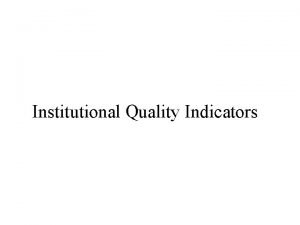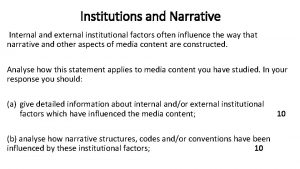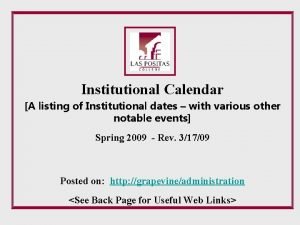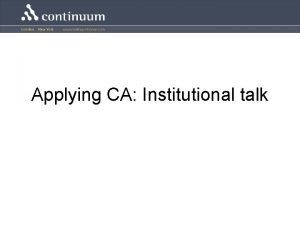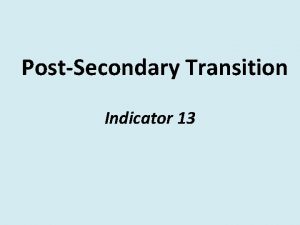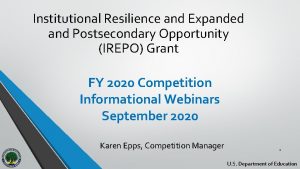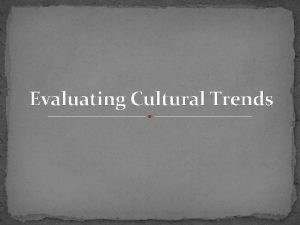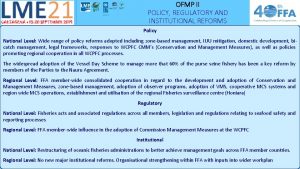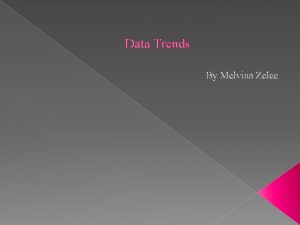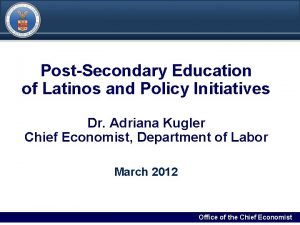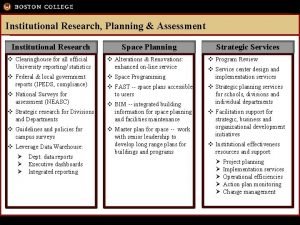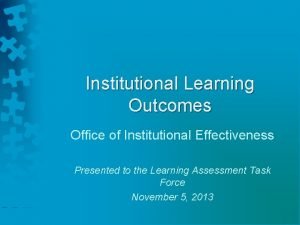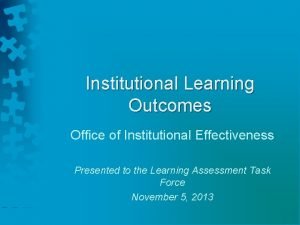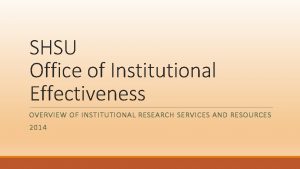Trends in Postsecondary Data Policy Institutional Data Voight




























- Slides: 28

Trends in Postsecondary Data Policy & Institutional Data. Voight Use Mamie Vice President of Policy Research Institute for Higher Education Policy October 25, 2018

IHEP is a research, policy, and advocacy organization that works to promote college access, success, and affordability, particularly for low-income students and students of color.

Page 3 IHEP Policy Priorities: Equity First 1. Use high-quality data to improve student outcomes 2. Strengthen and protect need-based financial aid 3. Enhance postsecondary opportunities for individuals impacted by the criminal justice system 4. Foster increased college access and degree completion for all students, especially underrepresented students and students who stop out

Page 4 The Postsecondary Data Collaborative (Postsec. Data) brings together organizations committed to the use of high-quality data to promote student success and educational equity. Image source: Maryland Gov. Pics

Page 5 Equity Imperative for Data: Lack of and transparency masks Policymakers, the public, students, institutions can’t answer key questions inequities. about student access, success, outcomes, and equity, like: How do college access, affordability, and completion vary by race, ethnicity, and income? How many community college students transfer to four-year colleges? After students transfer, do they go on to graduate? Which students go on to succeed in the workforce?

Page 6 Federal metrics fall short, Fail to count all students Image source: Count All Students Campaign, Association of Public & Land-grant Universities

Page 7 Striving for better data

Page 8 Toward Convergence: Postsecondary Metrics Framework Toward Convergence: A Technical Guide for the Postsecondary Metrics Framework

Page 9 Why don’t we have better data?

Page 10 Data systems are incomplete, duplicative, inefficient, and burdensome

Page 11 Can’t we do better?

Page 12 Can’t we do better? Yes.

Page 13 Can’t we do better? Yes. Create a secure, privacyprotected student-level data network.

Page 14 Why SLDN? Promote evidence-based decision making for students, policymakers, and institutions • Students have a right to know expected outcomes before investing time and money. • Institutions need streamlined reporting to minimize burden; need to know how students fare after leaving their institution. • Policymakers require quality information to steward taxpayer investment. • All stakeholders need quality information to examine and close equity gaps.

Page 15

Policy Solution: College Transparency Act (CTA) • Bipartisan, bicameral • 15 Senate and 33 House co-sponsors • Hatch (R-UT), Cassidy (R-LA), Warren (D-MA), Whitehouse (DRI) • Mitchell (R-MI) and Polis (D-CO) • 130+ supporting organizations Page 16

Page 17 What about privacy and Student privacy is of the utmost importance: security? Limit who can access which data for what purposes • Data minimization: Limit what data are collected • Data access: Limit who can access data (house at NCES) • Data use: Limit how data can be used • Data governance: Guide system implementation

Page 18 How are institutions using the data they do have?

Page 19 Leading with Data How senior institution and system leaders use postsecondary data to promote student success

Page 20 Leading with Data 1. Lead by example to set a culture of data use for institutional improvement. 2. Distribute data responsibilities widely. 3. Reach beyond campus boundaries to find and use data. 4. Save a seat at the data policy table.

Page 21 Set a culture of data use • Ask, ask for data and only make decisions when provided with evidence • Require department heads to bring data to regular meetings • Create a data-driven, campus-wide student success committee – and meet regularly to discuss the data • Start with practice-relevant questions

Page 22 Set a culture of data use • Help today’s students: Early alert systems • Help tomorrow’s students: Uncover and address systemic barriers

Page 23 Distribute data responsibilities widely • Value the IR office • But involve others: registrar, financial aid, academic advising, student affairs, business services, faculty

Page 24 Reach beyond campus boundaries to find and use data • Consider state and federal data sources • • • IPEDS for benchmarking State longitudinal data systems State UI records Federal workforce outcomes (e. g. UT-Census partnership) Local data on workforce needs

Page 25 Save a seat at the data policy table • Incorporate institutional views into data policy conversations

Page 26 Coming soon… • Metrics Framework Guidebook • Interactive Policy Summit

Page 27 Interactive Policy • Co-hosted with Association for Institutional Research (AIR) in Summit Summer 2019 • Ideal team includes executive leadership, IR, IT, government relations, other data producers and users (e. g. enrollment managers) • Primary goals: • • • Foster a data-informed culture on campus designed to improve student success. Generate conversation and knowledge sharing between institution and policy experts. Strengthen advocacy among institutional representatives to encourage engagement in state and federal policy discussions.

Thank you! Mamie Voight mvoight@ihep. org @IHEPTweets @Postsec. Data
 Jerry yeh
Jerry yeh Voight futcher lines
Voight futcher lines Postsecondary education readiness test
Postsecondary education readiness test Postsecondary education options
Postsecondary education options Arizona commission for postsecondary education
Arizona commission for postsecondary education Alaska student aid portal
Alaska student aid portal Relocation trends
Relocation trends Wisconsin long term care partnership program
Wisconsin long term care partnership program Examples of institutional catering
Examples of institutional catering Institutional presidency definition
Institutional presidency definition Eu institutional triangle
Eu institutional triangle Institutional affiliation meaning
Institutional affiliation meaning Institutional dimension of religion
Institutional dimension of religion Tie in promotion
Tie in promotion Product vs institutional promotion
Product vs institutional promotion New directions for institutional research
New directions for institutional research Richard tuffs
Richard tuffs What is institutional completeness
What is institutional completeness Institutional voids
Institutional voids Institutional theory
Institutional theory Institutional risk definition
Institutional risk definition Proxy for institutional quality
Proxy for institutional quality Disadvantages of commissary food service system
Disadvantages of commissary food service system Institutional anomie theory definition
Institutional anomie theory definition Institutional support and entrepreneurship
Institutional support and entrepreneurship Sonia liou
Sonia liou Institutional factors media
Institutional factors media Institutional calendar
Institutional calendar Institutional building
Institutional building





















